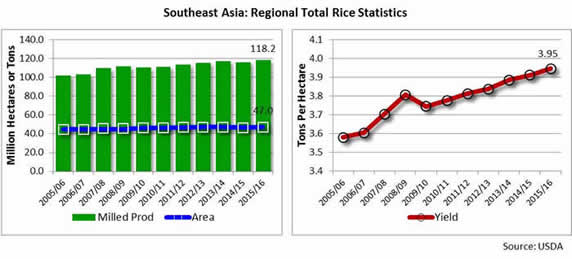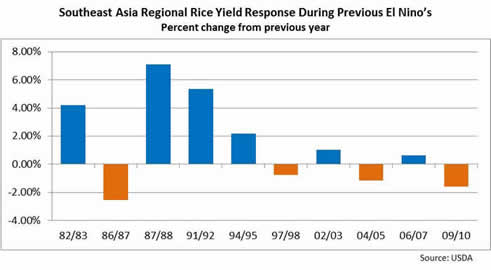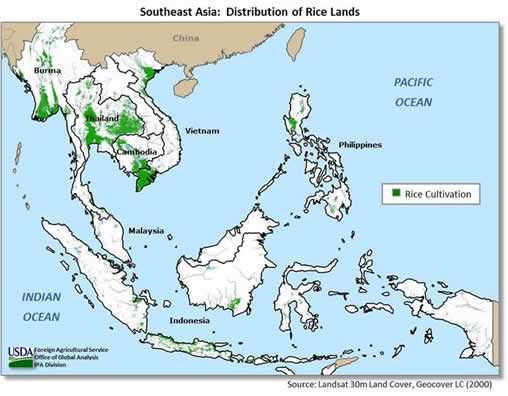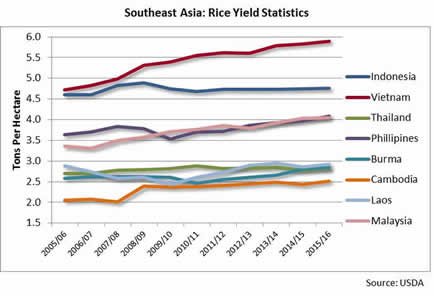Southeast Asia: 2015/16 Rice Production Outlook at Record Levels
As the 2015/16 growing season gets underway in Southeast Asia, USDA is forecasting total milled rice production at a record 118.2 million tons. This forecast acknowledges the region’s historical pattern of annual yield growth - resulting from the gradual expansion of acreage under irrigation and improved high-yielding rice varieties. This early forecast also includes an assumption of a near-normal rainfall pattern during the main growing period from June to October when the majority of rainfed rice is cultivated and grown.
USDA is aware that international weather forecasting organizations have recently issued alerts regarding the development of an El Niño, as early rice crops are being sown throughout the region. It should be noted that El Niño’s have historically had both positive and negative impacts on rice yields in Southeast Asia, and therefore the current outlook from a forecast perspective is neutral. USDA routinely monitors actual rainfall accumulations and crop conditions worldwide, and will adjust individual country-level rice forecasts in upcoming months when warranted.

Eight countries are grouped together in this analysis of Southeast Asia. They are: Indonesia, Thailand, Vietnam, Burma, Philippines, Cambodia, Laos, and Malaysia. Rainfed rice typically makes up approximately 55% of total rice production in Southeast Asia, and is highly dependent on timely and consistent water availability in both upland and lowland paddy fields where it is cultivated. Drought is the most important limiting factor influencing annual production potential, and is usually associated with an erratic or intermittent rainfall pattern which leaves crops dry for periods of weeks at a time. The rice varieties grown in Southeast Asia are highly sensitive to drought stress, with the greatest losses occurring when the crops are in the flowering or reproductive growth stages. Currently major meteorological organizations are warning that a moderate to severe El Niño event is developing in the Pacific Ocean, and these events typically influence the timing and intensity of rainfall and tropical storms in Southeast Asia. Historically speaking, Southeast Asian countries have experienced significant climate-related problems associated with past El Niño’s, with Indonesia and the Philippines often experiencing deficient rainfall or drought.

El Niño events occur on a fairly regular basis, and are each unique in the way they influence rainfall patterns and agricultural production in Southeast Asia (http://www.fas.usda.gov/data/southeast-asia-historical-el-ni-o-related-crop-yield-impact). For example, there have been 10 documented El Niño’s between 1980-2013, with an average occurrence of one every 3.5 years. According to NOAA, 3 strong, 5 moderate, and 2 weak El Niño episodes occurred during this 34-year period. The regional-scale crop response in Southeast Asia to these 10 historical El Niño’s was quite varied, as seen in the graph above. Not only was there a wide-range in the net positive or negative crop responses, but there appears to be no relationship between the regional crop yield response and the actual severity of the El Niño event itself. The reasons for this are likely related to the variation in the timing of the onset of each El Niño (which month of the year), its duration (how many crop seasons/cycles are impacted), and the geographical scope of its rain-dampening effects (which countries are affected). The conclusions that can be drawn from this data point us to a general expectation for variable crop yields during El Niño’s, but not necessarily to a substantially negative outcome for the region as a whole.

As can be seen in the map above, rice is cultivated on a widely throughout the region, with the most significant concentration of acreage in the mainland countries stretching from Burma in the west to Vietnam in the east. Total area in 2015/16 is estimated by USDA at 47.0 million hectares, of which approximately 45 percent or 21.0 million hectares are irrigated. Rice farms are typically small in size, averaging from 0.5 – 2.0 hectares in total area. Rice is grown throughout the year during both monsoonal (rainy) and winter (non-rainy) periods. Rice grown in the dry season is typically irrigated, and covers a small proportion of the total area devoted to rice in any given country. For example the area devoted to dry season rice in Thailand, Cambodia, and Laos accounts for roughly 19, 16, and 11 percent of total rice area, respectively.

The majority of both rice area and production in the region emanates from Indonesia, Thailand, and Vietnam. These major producers account for approximately 73 percent of total milled rice production. Burma and the Philippines are middle-level producers, with both country's governments keen on increasing output over the coming decade. Burma hopes to become a major exporter while the Philippines wants to achieve rice self-sufficiency. Cambodia, Laos, and Malaysia are minor producers, though both Cambodia and Laos have ambitious plans to increase crop yields and production to enable greater export potential. Rice yields vary enormously throughout the region. Vietnam (the highest) has rice yields more than double (134 percent) the yields in Cambodia (the lowest). The wide divergence is generally associated with differing levels of acreage under irrigation, varieties sown, and technology applied (fertilizer, pesticides, extension services).

Country Highlights:
Indonesia
Rice area in 2015/16 is estimated at 12.2 million hectares, up 0.1 million hectares or 1 percent from last year. Milled rice production is forecast at 36.7 million tons, up 0.35 million tons or 1 percent from last year. Cultivated rice area has plateaued in the country, though the government is attempting to increase acreage in non-traditional locations (islands outside of Java). Area growth this year is expected to come from a shift of acreage in the 3rd growing season of 2014/15 being harvested later than normal, coinciding with the beginning of the 2015/16 crop year – not from expansion. Barring the development of drought conditions in 2016 related to the brewing El Niño, rice yields are currently forecast to increase marginally over last year. Indonesia is one of the few countries in the region that often experiences rainfall deficiencies during El Niño events. The first of three annual rice crops will be planted in October 2015 and harvested in the January-March period of 2016.
Vietnam
Rice area in 2015/15 is estimated at 7.7 million hectares, down marginally from last year. Milled rice production is estimated at 28.2 million tons, up 0.2 million tons or less than 1 percent. Rice yields are forecast at 5.89 tons per hectare, up roughly 1 percent from last year. National rice area is projected to decline over the next few years as the government promotes the expansion of alternative crops such as corn and soybeans. The government is targeting marginal yielding rice lands for this land conversion program. Vietnam has three different rice seasons, called the winter, spring, and autumn crops. Winter rice area has been in decline for 20 years, as its low relative yields have made it vulnerable to alternative cash crops with higher profitability. The autumn crop, however, has seen acreage gradually increase over the same time period, with strong growth in annual yield. Reports from USDA/Ho Chi Minh City indicate that both the winter and autumn crops will lose approximately 20,000 hectares each to corn and soybean this year under the government program.
Thailand
Rice area in 2015/16 is estimated at 10.7 million hectares, up 0.4 million hectares or 4 percent from last year. Milled rice production is forecast at 19.8 million tons, up 1.0 million tons or 6 percent from last year. Rice yields are estimated at 2.81 tons per hectare, up 1.5 percent from last year. Rice area is expected to recover from last year, assuming that the summer rains will be adequate enough to replenish depleted reservoirs that support winter dry season rice cultivation. Government restrictions on irrigation supply during the recently completed 2014/15 dry season crop caused an unusual drop in total 2014/15 rice area. Recovery of much of this productive acreage is predicated on near-normal rainfall in 2015 and an easing of official government restrictions concerning distribution of irrigation supply during the 2015/16 dry season. Thailand has two rice growing seasons (wet and dry) with roughly 70 percent of total production occurring during the wet season.
Philippines
Rice area in 2015/16 is estimated at 4.8 million hectares, down about 1 percent from last year. Milled rice production is forecast at 12.4 million tons, up 0.2 million tons or 2 percent from last year. Rice yields are estimated at a record 4.08 tons per hectare, up 3.0 percent from last year. The government’s primary aim to become self-sufficient in rice production is beginning to bear fruit, as national irrigated area and the acreage sown to high-yielding varieties gradually increases. Both of these factors are boosting national average rice yields, which have increased a little over 1 percent annually over the past decade. The Philippines is another country that experiences periods of deficient rainfall or drought during El Niño events. It also experiences fewer typhoons and tropical storms during El Niño years, which can be both a positive and negative insofar as agriculture is concerned. Fewer storms mean less storm damage but also less rainfall. Barring the development of significant drought this year, trend rice yield is forecast - a record level.
Burma
Rice area in 2015/16 is estimated at 7.1 million hectares, up less than 1 percent from last year. Milled rice production is forecast at a record 12.8 million tons, up 0.2 million tons or 2 percent from last year. Rice yields are estimated at a record 2.84 tons per hectare, up 1.0 percent from last year. International investment in irrigation infrastructure is reportedly aiding Burma in improving its rice production potential. This is largely happening through modest expansion of irrigated acreage during the winter dry season as new systems are completed.
Cambodia
Rice area in 2015/16 is estimated at 3.1 million hectares, up nearly 1 percent from last year. Milled rice production is forecast at a record 4.9 million tons, up 0.2 million tons or 4 percent from last year. Rice yields are estimated at a record 2.51 tons per hectare, up 3.0 percent from last year. Cambodian rice area has steadily expanded over the past two decades as farmland that was overgrown or disused since the war period of the 1970’s and 1980’s was gradually brought back into production. This process is expected to continue, with area increasing roughly 25,000 hectares in 2015/16. The country has some of the slowest growing rice yields in the region, owing to the extremely limited use of improved high-yielding varieties. Crop yields in 2015/16 are expected to improve to near-normal levels, compared to a disappointing 2014/15 season which had crop yields decline roughly 2 percent from drought.
Laos
Rice area in 2015/16 is estimated at 0.9 million hectares, up nearly 2 percent from last year. Milled rice production is forecast at a record 1.7 million tons, up 4 percent from last year. Rice yields are estimated at a near-record 2.91 tons per hectare, up 2.0 percent from last year. The government of Laos has been encouraging farmers to increase rice area in lowland areas, while reducing acreage sown in the steep mountainous uplands. Both of these changes should lead to improved rice yields over the long-term. The increase in rice area forecast this year is predicated on government investment to rehabilitate damaged irrigation infrastructure in the capital region that was damaged by floodwaters two years ago. Should this irrigated rice land come back into production, national crop yields should recover to near-normal levels.
Malaysia
Rice area in 2015/16 is estimated at 0.7 million hectares, up less than 1 percent from last year. Milled rice production is forecast at a record 1.8 million tons, up nearly 1 percent from last year. Rice yields are estimated at a record 4.04 tons per hectare, up less than 1 percent from last year. Area growth has been extremely limited in Malaysia for many years, as most producers are more interested in cash crops rather than food crops. The Malaysian government has been trying to encourage increased rice production in recent years through subsidies for crop inputs. Crop yields have increased an average of 2 percent per annum over the last decade, so these support programs have had some success. Marginal increases in both are and yield are forecast for 2015/16.
This report has been published by the Office of Global Analysis (OGA), International Production Estimates Division (IPAD). Current USDA area and production estimates for grains and other agricultural commodities are available on IPAD's Agricultural Production page or at PSD Online.
|

